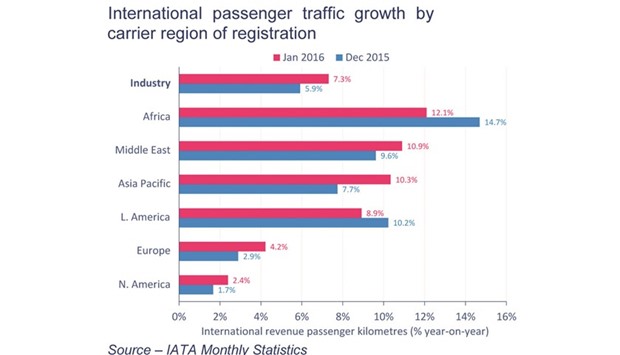Middle East carriers had the strongest year-on-year demand growth in passenger traffic in January at 10.9%, helped by ongoing network and fleet expansion, the International Air Transport Association (IATA) has said in a report.
Capacity rose 12.9% and load factor dipped 1.4 percentage points to 77.8%, it said.
In the Middle East, the demand growth is spurred by the rapid fleet and network expansion by Qatar Airways, Emirates and Etihad, which are dubbed ‘Gulf 3’.
IATA’s global passenger traffic results for January 2016 showed demand (revenue passenger kilometres, or RPKs) rose 7.1% compared to January 2015. This was ahead of the 2015 full year growth rate of 6.5%. January capacity rose 5.6%, with the result that load factor rose 1.1 percentage points to 78.8%, the highest load factor ever recorded for the first month of the year.
According to IATA, airlines have continued to react to robust travel demand by adding capacity cautiously (total available seat kilometres increased by 5.6% year-on-year in January).
As a result, at 78.8% in January, the industry load factor was the highest ever recorded in the month, 1.1 percentage point higher than in the same period in 2015.
In fact, passenger loads reached an all-time January-high in four of the six regions, and were just 0.1 percentage points below their record high in North America too. As was the case in 2015, the Middle East remains the notable exception, with capacity growth continuing to outstrip even double-digit annual growth in passenger traffic.
Underlying conditions continue to point to another strong year of growth for passenger traffic. While the global economy continues to face downside risks, another year of modest economic growth will not present a major headwind. Moreover, although the downward trend in global air fares eased towards the end of 2015, the additional decline in oil prices seen during the final months of last year and into January is likely to provide further stimulus for air travel growth during the course of 2016, IATA said.
IATA director general and CEO Tony Tyler said, “January maintained the strong traffic growth trend seen in 2015, showing the resilience of demand for connectivity despite recent turmoil in equity markets. The record load factor is a result of strong demand for our product and airlines making the most productive use of their assets. Underlying conditions point to another strong year for passenger traffic, with the latest decline in oil prices likely providing additional stimulus for air travel growth.”

..


